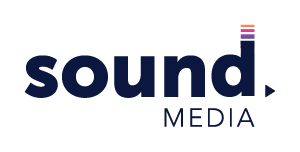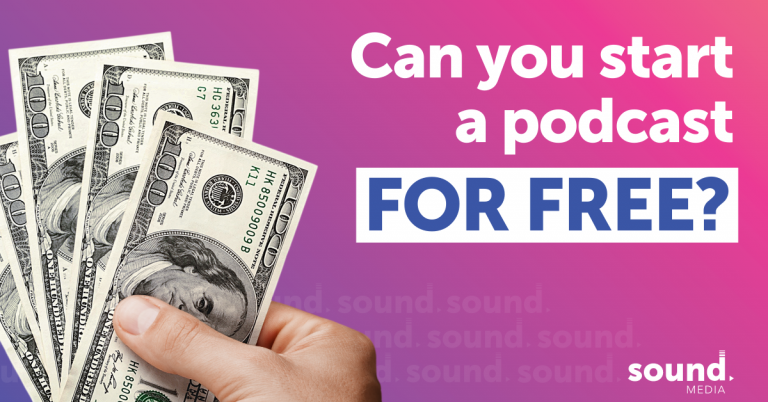It’s a simple question, isn’t it? Can you launch a podcast for free?
Essentially, yeah, just about.
In this blog, I’ll run through the free options for each part of the podcast launch process, their benefits, and their pitfalls.
Hands up – I sell podcast services. If everyone did it for free, I’d be out of work. But I’d never try to keep information from anyone, so everything in this piece is written with honesty and integrity.
For each element, I’ll offer up both a free option and my recommended option.
Strategy
I’m a big believer that every podcast needs a strategy. This includes a clear outline of what the aim is, the overall podcast idea, the format and structure of episodes, and a few other factors. It’s the glue that holds all the other elements together and without a clear strategy, you’ll find yourself drifting and likely hitting a bit of a podfade wall within a few months.
Free option: Do it yourself! Put some time aside to brainstorm and put together a podcast strategy
Recommended option: Bring in an expert. A good podcast consultant or strategist will spot the gaps and pitfalls and help put together a rock solid plan. This is, by the way, what we specialise in here at Sound Media. Shameless plug.
Hosting
Your audio hosting platform is where you upload your episodes, so people can listen to them. They’ll probably listen via an app like Spotify or Apple Podcasts, but they simply play the audio from your hosting platform. Basically, a hosting platform is an absolutely essential part of the podcast mix.
There are many hosts out there. Some offer a ‘free’ tier which has some limits – for example, only allowing you a certain amount of server space each month, or a monthly bar on the total length of episodes you can upload. I see these as ‘freemium’ models – the whole idea is to get you onto their platform, then at some point you’ll hit the limit and have to move on a paid tier.
For example, some people use Buzzsprout for hosting because of its free tier – but you can only upload two hours of episodes a month, and they are taken down after 90 days.
The clear exception to this rule is Anchor. This is Spotify’s own hosting platform and as such, the costs are covered by the company. So it is free and doesn’t have those limitations. Anchor’s had its critics over the years, but has ironed a lot of issues out and is a solid hosting platform. You won’t get many extra features, or help to grow your show, and managing multiple podcasts is tricky, but it does a job.
Free option: Anchor
Recommended option: Captivate* – the hosting platform I use myself and always the one I recommend. It has everything, including tools to make it easier to manage your show, along with support for multiple podcasts, team members, your own podcast website, top class support, and loads more.
Recording equipment
This is where things get a little tricky, as the recording equipment needs differ depending on format. If you’re doing a show with five or six people, you’ll need a different set up compared to if it’s just you by yourself.
So firstly, if it is indeed just going to be you – no guests, no other voices – this is much easier to answer. You’ll get the best sound quality by recording into a voice recorder app on your smartphone. iPhones in particular are really quite good. If you’re recording with someone else, face to face, you can also use your phone as a makeshift mic, moving it between you and your guest depending on who is speaking. It’s not ideal, but it works.
The other side of this is if you’re recording with multiple people, virtually. This is how most podcasts operate now. Chances are, you’re going to be reliant on internal mics in laptops or webcams. In the last couple of years, these have come a long way, and are much better quality, but of course not everyone has a newish laptop.
The really key thing in this situation is to make sure you – and your guests – are in the best possible recording environment. You want to be in the smallest room you have, preferable with curtains closed and lots of other things in there which absorb the noise – clothes, blankets, duvets are all useful. Get nice and close to your laptop – don’t stick in on the other side of the room – and you will give yourself the best chance of capturing a decent quality of sound. And make sure everyone is wearing headphones – this stops echo and other sound issues.
Free option: Use your smartphone, or internal laptop mic, but focus on getting your recording environment right. Bonus – you’ll find loads of useful advice about maximising your recording environment in this episode of Pod Almighty
Recommended option: Buy a mic. Just a simple USB one will give clear and noticeable improvements in sound quality. For less than a hundred quid, you can bag this neat little Rode mic or this highly thought of Samson
Recording platform
Of course, if you’re doing a remote podcast, you’ll need to use a recording platform. The free options here are pretty clear, as we’ve been using them for the last couple of years during the various lockdowns, Zoom being the obvious one.
The downside is these platforms are reliant on your respective internet connections. If you or one of your guests has dodgy internet, that is reflected on your recording, simple as that.
Specialist podcast recording platforms get around that by capturing each person’s audio at their end of the call, and then uploading it afterwards. So even if their internet connection is iffy, you’ll get a top quality recording for each guest.
Free option: Zoom, Teams, Google Meets, etc – take your pick!
Recommended option: Squadcast* and Riverside* are both excellent and offer fair priced audio-only entry level tiers
Editing
You’ll need to turn your recordings into a finished podcast episode – this means cutting out the bits you don’t want, probably getting rid of some of the ums and erms, tidying everything up, adding on intro / outro / music elements, etc.
Again, you’ll find a multitude of options. For example, Anchor has its own built-in episode builder, which will mix different elements together for you. I must admit I struggled to use this, and have heard very mixed reports from other podcasters.
By far the best free choice is Audacity – an option source editing programme. This will let you make all the edits you want to your tracks and mix them all down into a single track ready for release.
Audacity is quite feature rich, although getting to grips with it will take a bit of time. The good news is that Audacity is incredibly widely used around the world, so there are huge numbers of tutorial videos on YouTube. If you get stuck – you Google what you want to do, and chances are there will be a tutorial to follow.
A word of caution that Audacity is open-source and as-such, it isn’t perfect. It can crash and it’s highly recommended to save your work regularly as you go. It’ll also take you a decent chunk of time – editing an hour long podcast will likely take you somewhere around 3-4 hours.
Free option: Audacity, and tap into the global knowledge base to help you as you go
Recommended option: Outsource. Get someone who really knows their onions to edit and craft your podcast episodes. You know this coming – it’s something we offer and have been doing for aaaaaages for lots of happy clients, for very reasonable prices. If editing yourself takes up, say, half a day, it’s worth balancing that against the cost of outsourcing.
Basic Marketing
You don’t HAVE to market your podcast, but if you agree that it is worthwhile having a strategy, then I’m sure you will see the value in the follow up work. Without it, you’re talking into a bit of a void. You should probably be spending as much – if not more – time on the publicity and marketing of your show, as you do on the prep and recording processes.
Thankfully the free options here are good. Social media is a clear and established way of promoting a show, and engaging with an audience. Chances are you already have some sort of social presence, so a lot of the leg work is done.
But you’ll want some visuals as well. In fact, you will NEED some visuals – every podcast has a square ‘cover art’ image which appears when it plays, and that will need creating right at the start.
God bless Canva. Even the free tier is tremendous, and will allow you to create templates and images of a really high quality, without huge demands on your time. I use Canva Pro and that’s still very reasonably priced.
Free option: Social media and Canva
Recommended option: I’d actually STILL recommend social media and Canva, possibly the Pro level, but the next step up is to also get yourself a designer to create your initial cover art and help shape your podcast identity. You might decide to continue using them for ongoing design work as they will likely come up with stuff better than me or you can ourselves!
* Note these are affiliate links – which means we get a modest kick-back if you sign up via them. In no way whatsoever does this influence the recommendation, and we won’t be offended if you sign up using the standard link. Our recommendations are honest, genuine, and based on several years of intensive podcast experience.



